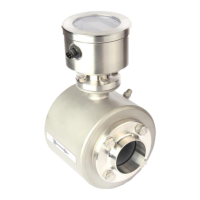
Do you have a question about the ANDERSON-NEGELE FMQ and is the answer not in the manual?
| Brand | ANDERSON-NEGELE |
|---|---|
| Model | FMQ |
| Category | Measuring Instruments |
| Language | English |
Introduction to the manual and device function.
Detailed specifications for converter, transmitter, and measuring ranges.
Key technical details for both main components.
Table detailing flow ranges for different nominal widths.
User responsibility, manual adherence, qualified personnel, general safety rules.
User responsibilities, intended application, and misuse warnings.
Safety rules, electrical connection, personnel qualifications.
Specific hazards and explanation of safety symbols used.
Guidelines for transport, device dimensions, and weight.
Table of dimensions (W, D, H, H1, H3) and weight.
Lengths for welding sockets and TriClamp connections.
Requirements for installing the transmitter in the product line.
Importance of gas-free liquids and conductivity for accurate measurement.
Recommended fitting positions and essential grounding for reliable measurement.
Crucial conditions for accurate operation.
Step-by-step guidance for installing the transmitter and converter.
Guidelines for fitting, tightening, and handling leaks during transmitter install.
Protecting the converter from moisture and ensuring proper support.
Requirements for power supply installation.
General information and safety for commissioning.
Procedures for initial startup and calibration.
Using the keypad, display navigator, and accessing measured values.
How to use the keypad and navigate the device menus.
How to modify device settings like language, dimensions, and outputs.
Configuring pulse and current output parameters.
Accessing service data and simulation functions.
Simulating analog output and flow for testing purposes.
Settings for LFS, MSPE, BSPE, Average.
Setting calibration factors (MSPE, Offset, SPAN).
Setting the field calibration factor for accuracy.
Adjusting the sensor offset and span values.
Access to advanced functions like zero adjust.
Detailed procedure for performing zero adjustment.
Specifications for flow linearity, reproducibility, and reference conditions.
System self-diagnostics and error messages via display.
Comprehensive list of errors and their solutions.
Troubleshooting common issues like no flow or signal.
Steps for no flow rate, no analog signal, or deviations.
Essential safety precautions for performing maintenance tasks.
Recommended maintenance steps like cleaning and seal checks.
Steps to prevent issues and ensure longevity.
Procedures for sending the device for repair and handling.
Conditions and warnings for returning the meter for repair.
Steps for replacing the transmitter unit.
Using software functions for troubleshooting and verification.
Simulating flow to aid in diagnosis or setup.
Information on spare parts and factors influencing their need.
Procedures for temporary and final disposal of the device.